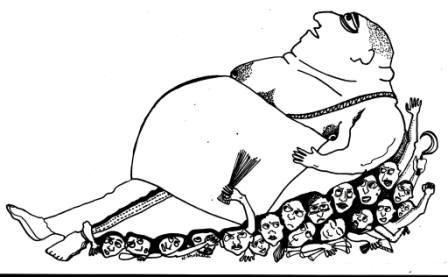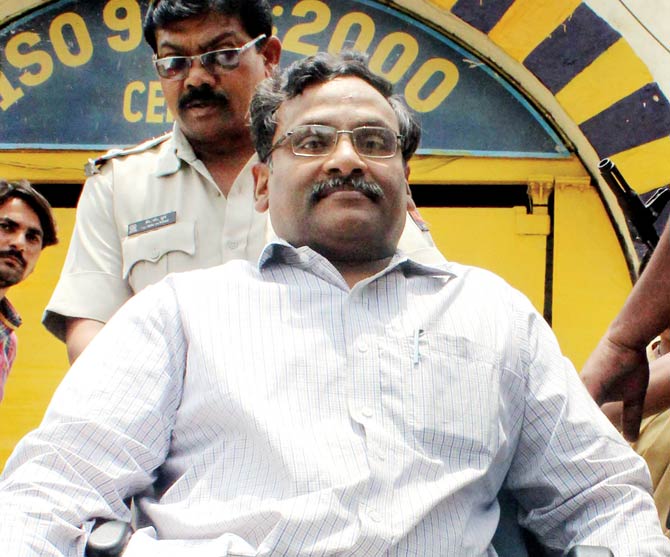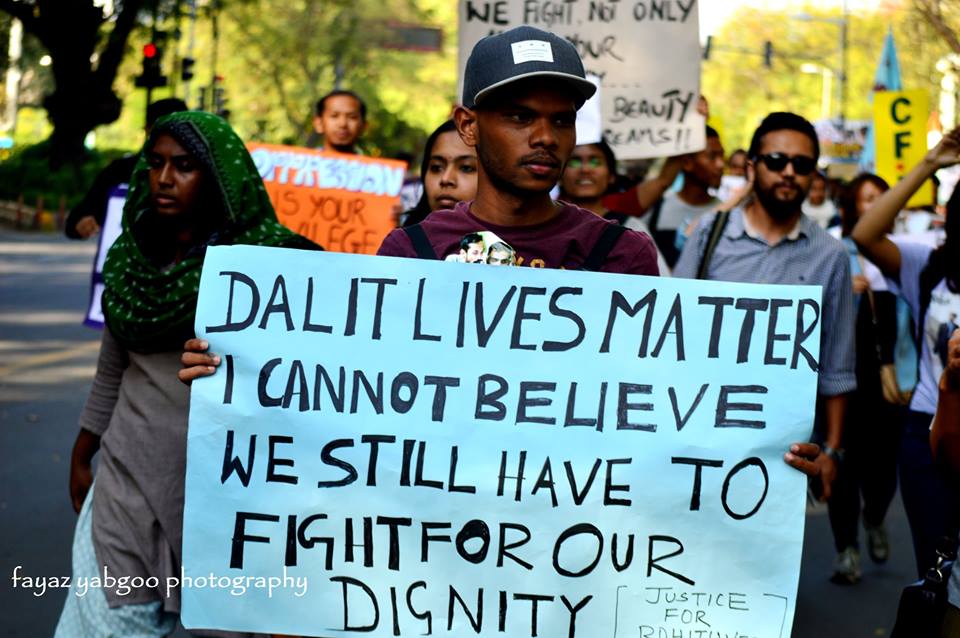N. Sukumar and Shailaja Menon
“The backward classes have come to realize that after all education is the greatest material benefit for which they can fight. We may forego material benefits, we may forego material benefits of civilization, but we cannot forego our right and opportunities to reap the benefit of the highest education to the fullest extent. That the importance of this question from the point of view of the backward classes who have just realized that without education their existence is not safe” ~ Dr. B. R. Ambedkar1
On 17th January 2016, Rohith Vemula, the research scholar at UoH committed suicide hounded by the insensitive university administration to the HRD ministry. It is indeed intriguing that an array of forces considered an ordinary research scholar a threat to their entrenched interests. Rohith’s erudition inspired the ASA. Though originally conceived as an organization to champion the cause of Dalit students who gate-crashed the abode of ‘Saraswathi’, gradually, it built a coalition comprising the dalits, Muslims, tribals and students of the North East on campus. This enabled the ASA to successfully challenge the hegemonic brahmanical discourse prevailing on the campus. The ideological opponents of the ASA, the ABVP, finally had to resort to political bullying that ultimately led to the silencing of Rohith.

In order to salvage the situation, many narratives emerged- questioning the caste identity of Rohith, attempts to create fissures among the protestors, the police action in JNU on cooked up charges of sedition. The icing on the cake was the melodrama witnessed in parliament where the honorable HRD minister Smriti Irani, infantilized Rohith and mounted a passionate cover-up of her ministry’s misdeeds. In the entire drama, the VC of UoH Appa Rao Podile had gone underground. Apparently, his political masters would have advised him to lie low till the storm blows over. On March 22nd, he emerged out of hiding to rejoin the university as VC. Public memory is undoubtedly fickle and Appa Rao can be excused for thinking that all is well. After all, his bosses had meticulously planned his comeback, aided by the stooges on campus.2 Various tasks (list available on social media) were earmarked for faculty, non-teaching and only Life Sciences students to organize a grand welcome for the VC.
Interestingly, one list is headed –Tasks for Appa Rao, who has assigned these tasks for Appa Rao? These are not official notes, lacking any signage, so who prepared them and circulated these notes? The tasks cover everything from the mundane milk and water to the security cameras and the police. So, some scheming brainwork is evident in the entire drama which needs investigation. For the protesting students and their supporters, this was the proverbial straw on the camel’s back. Obviously, a protest marked his return and the administration called the RAF to deal with the situation. “This is gross violence. Students resorting to this kind of violence…Without following some democratic processes…It’s really unfortunate for the education system. Students must know the democratic way of representing their issues,” observed Prof Podile3. His administration had a very ‘democratic’ way of dealing with students like Rohith. From July, the university stopped paying Rohith his monthly stipend of Rs 25,000 (excluding HRA), with friends alleging that he was targeted for raising issues under the banner of Ambedkar Students Association (ASA). A university official denied the allegation, blaming the delay on “paperwork”4.
Sadly, the relationship between the VC and the students has become so fragile that instead of uttering a word of solace or regret at the unfortunate events in UoH, the VC exhibited his coziness with the central government and called for security from a paramilitary force which routinely is used to quell communal riots, insurgency and threats against national security. The video footages reflect the brutal onslaught on girl students who were part of the group. The students were pushed around, chased across the campus so that the VC can resume office. The mess halls in the hostels were asked to be shut so that the students will be starved of food. The water supply was curtailed and access to the internet was denied. The entire campus is shrouded in secrecy as even the media is kept at bay. The campus has been reduced to a war zone and the administration is acting as an occupation force. The hapless students are venting their angst on social media; they are not part of the Newshour debates promoted by the ‘nationalist media’.
Fervent appeals have been posted to coordinate food and water supplies on campus asking for support from the civil society. Is the UoH an enemy territory that needs to be ‘liberated’ so that the VC and his sycophants can ‘rule’ in peace? At the last count, around 25 students and 3 teachers are in police custody. The teachers were attempting to pacify the tempers at the VC’s lodge and have been sympathetic to the students’ plight. One teacher (Dr. Ratnam, a Dalit faculty who heads the Centre for Ambedkar Studies) has been targeted in the past also when the present VC was the Chief Warden and the teacher in his capacity as the hostel warden did not acquiesce to raid the hostels. These teachers have continuously engaged with the students to instill confidence in them and assist their academic progress. One can discern a method in the madness. An attempt was made on the life of Prof. Vivek Kumar in Gwalior. Prof. Nivedita Menon has been embroiled in false cases in an endeavor to silence protests. Suddenly, JNU teachers are persona non grata in the academic circuit. This begs the question; do the FTII, IIT Chennai, AMU, Allahabad University, UoH or the JNU students represent a threat to the ‘nation’?
The basic rationale of the university is the interests of the students. The ordinary security guards of JNU expressed more humanity than the ‘learned’ Prof. Podile when they protected Khalid and Anirban from prying eyes on JNU campus till they themselves surrendered. The VC is supposedly in a role of loco parentis to the student community and not getting them beaten up by para-military forces. This reveals the support structure buttressed by his caste arrogance and the institutional immunity.
The ‘Art of Suppression’ has been fine-tuned by the present government. Ironically, the state is celebrating the 125th birth anniversary of Ambedkar. PM Modi declared himself to be a bhakta of Ambedkar and his party seeks to appropriate Ambedkar’s legacy for electoral largess. However, dalit intellectual capital is considered dangerous and needs to be suppressed whether they are student organizations or teachers in various universities. On the one hand, he wants to woo the globe by displaying India’s soft power, while his minions unleash the entire arsenal of the state to silence any critique. From the corporate media to the judiciary everyone is singing only one tune- ‘if you are not with us, you are against us’. The shriller the tune, the closer one is to the current dispensation. For them, the university’s role is not to teach but rather to ‘manage’ students and convert them into docile subjects. The teaching process is essentially dialogic providing ample space to arguments and debates, which is considered very threatening and a waste of tax payers’ money. Students should stick to books and not ponder over the mysteries of the social or natural universe lest they turn into Rohits or Kanhaiyas. Such moral preaching smacks of elitism since majority of the dalits, Muslims, women or tribals are not employed by the formal economy which is taxed. On the contrary, the public sector universities are the only spaces where these groups have an opportunity to nurture their dreams. Why there is a silence around the Rs 1.14 lakh crore of bad debts for which the state is responsible?
Gradually, the slogan of ‘sabka saath-sabka vikas’ is losing its sheen. Empty posturing devoid of substance has not lead to any significant change in the people’s lives. The university is the only domain to forge an alternative imagination which interrogates any idea of homogeneity and celebrates plurality. In a significant gesture at capturing the youth votes, Modi began his electoral campaign by addressing the students of Shri Ram College of Commerce at Delhi University. Only time will tell if the misadventures at UoH and JNU will bury the massive mandate of 2014. The students fighting for justice are caught in the crossfire, vilified by the media and targeted by political parties. Many more innocent victims are being added to the list post Rohith’s sacrifice branded as ‘castiest’, ‘naxals’, ‘anti nationals’ and many new ‘enemies’ might be discovered. The hollowness of the Hindutva vision is exposed by their ‘tolerant’ mouthpiece, Anupam Kher who ridiculed the hallowed ideas of liberty, trust and freedom. For people of their ilk, “India is a country where: ‘IDEA’ is a simcard, ‘LIBERTY’ is a shoe, ‘TRUST’ is a condom And ‘FREEDOM’ is a sanitary pad ! Jai Ho.”6
~
Notes
1. Government of Maharashtra (1982), Babasaheb Ambedkar : Writings and Speeches, Vol. 2, p. 62
2. http://www.thequint.com/india/2016/03/23/leaked-hyderabad-university-planned-every-detail-of-vcs-return#.VvK-Y3FRF1k.facebook (accessed 24/3/2016, 12.21 am)
3. (http://www.business-standard.com/article/pti-stories/students-ransack-hcu-vc-s-official-residence-116032200381_1.html, 22/3/2016, 10.20 pm)
4. http://indianexpress.com/article/india/india-news-india/behind-dalit-student-suicide-how-his-university-campus-showed-him-the-door/ 22/3/2016, 10.25 pm)
5. Rs 1.14 lakh crore of bad debts : The great government bank write-off, http://indianexpress.com/article/india/india-news-india/bad-loan-financial-year-rti-rbi-bank-loan-raghuram-rajan-bad-loan-financial-year-rti-rbi-bank-loan-raghuram-rajan-1140000000000-bad-debts-the-great-govt-bank-write-off/#sthash.ofzjKye2.dpuf , accessed 24/3/2016, 12.44 am
6. Anupam Kher Verified account @AnupamPkher, 22/3/2016, 11.40 pm
~~~
N. Sukumar teaches Political Science at Delhi University. Shailaja Menon teaches History at the School of Liberal Studies, Ambedkar University, Delhi.
Illustration by Nidhin Shobhana,









